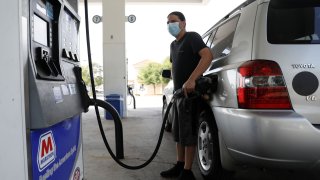
- Normally gasoline prices peak in the spring, but this year they are likely to keep rising through the summer, as the economy rebounds and oil prices rise.
- The national average for gasoline this Fourth of July holiday weekend will be the highest for the Independence Day holiday in seven years.
July fourth gasoline prices are expected to be the highest they've been for the holiday weekend in seven years, and they are forecast to rise even higher later in the summer.
The national average of $3.126 per gallon Friday is nearly a dollar more than prices were a year ago at this time, according to AAA. Analysts say the price could jump another 20 cents or more per gallon this summer.
It is unusual for gasoline prices to continue rising into the summer, and the last time that happened was in 2008 when oil surged to about $145 per barrel, according to Patrick De Haan, head of energy analysis at GasBuddy. West Texas Intermediate crude prices have jumped about 54% year-to-date to as high as $76 per barrel, and gasoline has risen with it.
"I think gasoline prices will plateau in the next three to six weeks," said De Haan. "It's probably going to be more like a 10 cent to 25 cent increase, but it's hard to nail down because of the economy."
De Haan and others said demand has been rising as the year has gone on and peak driving season, usually around the Memorial Day and July 4th holidays, could stretch on into this summer. Many Americans are returning to their offices and daily commutes in the fall.
"Usually prices peak in April to May," said De Haan. "This year is abnormal. You have GDP numbers accelerating into the summer, and demand for gasoline is accelerating."
Money Report
"We don't expect to see demand trail off like we've seen typically," said John Kilduff, partner with Again Capital. "The pandemic has changed the demand pattern. That's going to keep the pressure on gasoline supplies as people shun mass transit. There's just not going to be post July 4th relief at the pump that we're used to seeing. It's going to be a long, hot summer in terms of what you pay for gasoline."
Oil prices rallied Thursday, after the Organization of the Petroleum Exporting Countries was reported to be considering putting less oil on the market than expected. OPEC+ was discussing a 400,000 barrel per day increase, rather than a 500,000 barrel hike. Talks continued Friday.
Crude futures have been trading at the highest levels since October, 2018. West Texas crude futures jumped more than 2% Thursday and was flattish Friday, settling at to $75.18 per barrel. Brent crude futures, the international benchmark, gained 0.4% Friday, to settle at $76.17 per barrel.
Gasoline prices "are ticking higher as crude oil prices continue to rise, and as demand around the world has been recovering," said Andy Lipow, president of Lipow Oil Associates. "OPEC+ has been reluctant to restore production as demand has recovered, in order to reduce world inventories. OPEC has been concerned Iranian oil could return to the market and the delta Covid variant could potentially impact demand, so OPEC is keeping a tight rein on restoring production because they don't want to see a repeat of last year."
Tom Kloza, head of global energy research at OPIS, said he expects the national average for unleaded gasoline to reach about $3.35 in the next 60 days, and hit $4 in some places in the western U.S. California is already experiencing prices over $4 per gallon.
"I think clearly there's a lot of momentum for crude prices to go higher," said Kloza. "I think there's more pricing power. There's more aggressive pricing by retailers. I think they'll be that way even if demand doesn't get to the 2019 levels. In 2019, essentially July and August you were 9.5 million to 9.9 million barrels a day. That's a lot of fuel."
According to the Energy Information Administration, gasoline demand last week was 9.1 million barrels a day in the U.S., down from 9.4 million barrels a day the week earlier. That compares to 8.6 million barrels a day a year ago.






